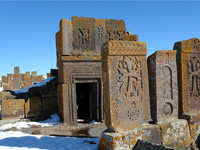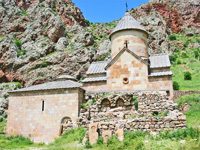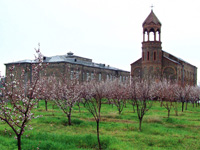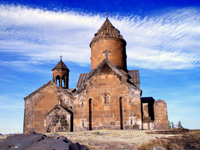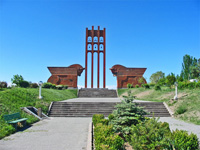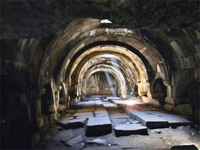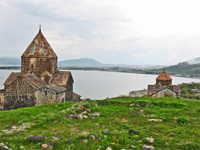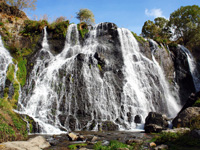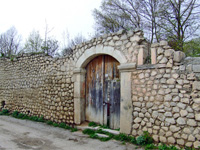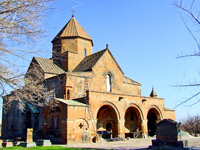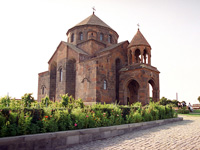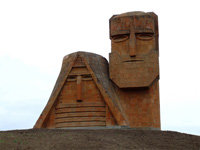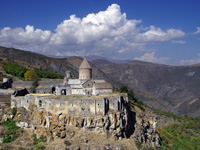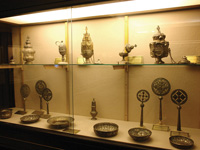
News
Car rental for 3 days: what should you visit?
As a car rental company, functioning in the insudtry for 15 years, we recommend following sights to visit, if you are for the first time (and not only) in Armenia.
Noratous
The art of khachkar (cross-stone) is the most original manifestation of Armenian medieval culture. Noratus which is truly considered to be a forest of khachkars and open-air museum, displays hundreds of khachkars, the most stunning of which are the so called "embroidered" ones typical to the 13th-14th centuries. This is a unique place, where one can reveal the development of khachkarial art in its historical process.
Noravank
Passing a narrow road surrounded by rocks of hundred caves one discovers a scene of harmony of architecture with nature. The monastery enshrined with fine architectural solutions and luxurious embellishments is one of the brightest examples of Armenian architecture of the 13th century. Noravank consists of St. Karapet, St. Grigory the Illuminator churches and St. Astvatsatsin (Holy Mother of God) two-storey church, which is notable for its ideal constructive and sculptural work.
Oshakan
Oshakan village has been a holy place since the 5th century, when in 440 due to the duke Vahan Amatuni's efforts the creator of Armenian alphabet Mesrop Mashtots was buried there and a small church was built over his tomb. In the 19th century a bigger church bearing the name of St. Mesrop Mashtots was constructed in the place of the old one. Every year many first class schoolchildren learn the first letter of the alphabet in this church after an oath at the tomb of St. Mashtots.
Saghmosavank
5 km far from Hovhanavank monastery on the edge of Kasakh river canyon, in the 13th century Vachutian dukes built Saghmosavank monastery. The main church is adjacent to the scriptorium, where many manuscripts have been produced during centuries. Saghmosavank underwent the devastating influence of the earthquake in 1988. The reconstruction comleted in 2000 returned the church its beauty and glory.
Sanahin
The monastery of Sanahin is on the right bank of Debed River. This architectural complex consists of several churches, seminary, book depository. The building of the seminary, which connects St. Astvatsastin (Holy Mother of God) and Allsaviour churches was from the outset built to make the edifices more earthquake resistant.
Sardarapat
This memorial sculptural complex is built in the sunny Ararat valley. By allegories it represents the Armenian-turkish battle in 1918 and glorifies the brilliant victory of Armenian people. Near the entrance of the complex there are two huge winged bulls symbolizing the persistence of Armenian nation and the alley fringed by five eagles leads to the Ethnography museum with a rich exhibition of Armenian culture, trades and crafts.
Selim
The Selim pass connecting Vayots Dzor and Gegharkunik districts, has been an important trade route from times immemorial. The long caravans with loaded camels were passing this way. Perceiving the necessity of having a place to stop after long and tiring journeys the Armenian duke Chesar Orbelian in 1332 ordered building a caravansary on this long serpentine road of Selim pass. This is a three nave building lightened only through the windows on the ceiling as out of security concern they foresaw no windows on the walls and even nowadays the mysterious darkness seems to keep some rumors from those far away days.
Sevanavank
A marvelous scene opens in the north-western part of Sevan Lake, where the peninsula towers over the transparent surface of the lake. Sevanavank monastery was built on the peninsula in 874 by the order of king Ashot Bagratuni's daughter princess Mariam. The silhouette of the churches against the background of the turquoise lake and blue sky casts unexplainable impression on the visitors.
Shaki waterfall
Shaki fall is in the southern part of Armenia, close to Sisian. The fall, being located in one of the cosiest and nicest corners of Syunik, gloriously opens its striking beauty to all admirers. The air here is full of inspiring melody of water and scent of mountains loading all their wafts.
Shoushi
Shoushi, the former capital city of Artsakh, is ten km far from Stepanakert. Shoushi is considered one of the oldest cultural and religious centers of Caucasus. The city is famous for its impregnable fortress and different historical sites. There is also a mosque of 18th century and St. Ghazanchetsots church restored in 1991-1994.
St. Gayane church
Not far from the Echmiadzin
Cathedral against the background of white peaks of Ararat one can see
the silhouette of the cupola of St. Gayane church. The church was built
in the 7th century and belongs to the domed-basilica style. According
to the legend this church was constructed over the tomb of Virgin Gayane,
who was martyred for preaching Christianity.
St. Hripsime church
St. Hripsime church is the one of the famous ecclesiastical buildings in the city of Echmiadzin. This is the developed and perfect example of cross-cupola churches in Armenia. The church is notable with its architectural simplicity and loftiness. The tomb of the Christian martyr Virgin Hripsime is in the sacristy of the church.
Stepanakert
Stepanakert is the capital city of Artsakh. It bears the name of great revolutioner Stepan Shaumyan. Stepanakert is constructed by the project of Alexander Tamanyan. The clean, cozy city has many nice buildings and parks. Here one can see the famous sculptural work "We and our mountains", known in the nation as "Grandma and Grandpa".
Tatev monastery
Among the architectural pillars of Zangezour the monastery of Tatev doesn't have its rivals. This used to be wealthiest medieval monastery in Armenia. Besides being a religious center Tatev was also the important strategical center of Syunik kingdom. Being situated on a naturally defended place Tatev monastery has always been an impregnable fortress for alien. In non-stable political conditions the several secret ways in the territory of the fortress led the way to the canyon and served as a link between the monastery and external world.
Treasures of Echmiadzin
The Museum "Treasures of Echmiadzin" is situated in the southeast section of the Cathedral. Unique holy relics and religious art are now housed in the museum. Among the many treasures are: the Holy Lance (Geghard) which pierced the side of Christ, housed in a silver reliquary; the relics of Noah's Ark in a reliquary that was created in 1698 and other valuable pieces of art. According to the history, the relic of Noah's Ark, was given to Patriarch St. Hakob (Jacob) of Mts'bna in the fourth century, as he desired to climb the peak of Mount Ararat to find Noah's Ark. After ascending the mountain, he fell asleep through the influence of God, and the angel of the Lord placed the reliquary of the Ark under his head. In a dream, the angel instructs St. Hakob to awaken, take the relic, and descend from the mountain. In addition to the pieces displayed, during archaeological excavations which were conducted due to renovation work of the Holy Altar, remnants of the original Holy Altar, founded by St. Gregory the Illuminator, dating back to 301-303 AD, were discovered.




